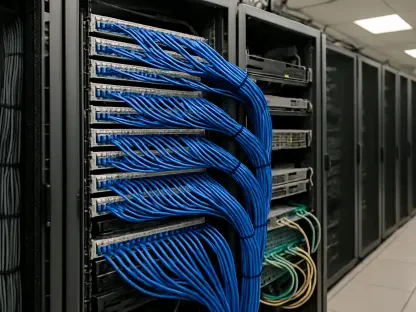Imagine a world where digital transformation races ahead at breakneck speed, powered by artificial intelligence and cloud computing, yet the backbone of this revolution—data centers—struggles to keep pace with unprecedented demands. In today’s hyper-connected landscape, these facilities are not just infrastructure; they are the lifeblood of global innovation. This report dives into the evolving realm of data center infrastructure, exploring how rapid technological shifts are reshaping requirements and highlighting the urgent need for adaptive solutions to ensure resilience and scalability in an unpredictable IT environment.
The Evolving Landscape of Data Center Infrastructure
Data centers stand at the forefront of technological progress, serving as critical hubs that support the explosive growth of AI, cloud computing, and digital transformation initiatives. Their role extends beyond mere storage and processing, becoming integral to business continuity and innovation across industries. As demands for real-time data processing intensify, the industry faces pressure to evolve rapidly, accommodating new workloads and ensuring seamless connectivity in a digital-first world.
The market comprises distinct segments, including hyperscale facilities catering to massive cloud providers, enterprise data centers for internal business needs, and edge data centers enabling low-latency processing closer to end-users. Each segment faces unique challenges driven by technological influences such as AI workloads requiring immense computational power, widespread cloud adoption, and the rise of high-density computing environments. These factors push the boundaries of traditional infrastructure capabilities.
Key players in this space include data center operators managing vast facilities, builders tasked with construction, end-users relying on uninterrupted services, and investors funding expansion. Amid these dynamics, the need for innovative approaches becomes evident, as fluctuating IT demands call for infrastructure that can adapt swiftly to changing requirements without compromising efficiency or reliability.
Current Trends and Market Dynamics in Data Centers
Key Trends Shaping the Industry
The surge of AI and cloud technologies has fundamentally altered data center requirements, necessitating higher power capacities and advanced cooling systems to manage heat dissipation from densely packed servers. This shift underscores a move away from conventional cloud deployments toward AI-intensive workloads, which demand robust resilience and redundancy to prevent downtime. Such evolving needs highlight the limitations of outdated infrastructure models in meeting modern expectations.
Emerging solutions like adaptive modular infrastructure are gaining traction as a response to these challenges, offering flexibility through prefabricated components that can be rapidly deployed. Market drivers such as speed-to-market, scalability to handle variable workloads, and a growing emphasis on environmental sustainability further shape industry priorities. These elements collectively push for more agile and eco-conscious designs.
Opportunities for innovation abound in both construction techniques and operational efficiencies, with stakeholders exploring ways to streamline processes while reducing carbon footprints. As digitalization accelerates, the focus on integrating cutting-edge technologies into data center frameworks becomes paramount, ensuring they remain competitive in a landscape defined by constant change.
Market Performance and Growth Projections
The data center market is experiencing significant expansion, fueled by global digitalization trends that drive demand for storage and processing capabilities. Current market size reflects robust growth, with performance indicators like increasing rack density and escalating power consumption pointing to a sector under strain to meet heightened needs. Deployment timelines are also shrinking as businesses prioritize rapid infrastructure rollouts.
Industry forecasts suggest continued upward trajectories, with predictions indicating rack power could reach 600 kW by 2027, signaling a dramatic shift in capacity requirements. Such projections emphasize the critical role data centers will play in supporting global IT infrastructure, as reliance on digital services deepens across sectors. The trend toward higher efficiency and density will likely intensify, shaping investment and design strategies.
Looking ahead, the expanding footprint of data centers in enabling connectivity and innovation globally cannot be overstated. Their evolution into more adaptive, scalable systems will be essential to sustaining the pace of technological advancement, positioning the industry as a cornerstone of future digital ecosystems.
Challenges in Traditional Data Center Construction
Conventional “stick-built” construction methods, which rely on sequential onsite assembly, are increasingly proving inadequate for today’s fast-paced demands. These approaches often result in slow deployment schedules, exacerbated by labor shortages that hinder progress. Inconsistent quality and unpredictable costs further compound the challenges, creating bottlenecks in an industry where timing is critical.
Delays in construction can have profound financial and operational repercussions, especially in a competitive market where speed-to-market is a differentiator. Businesses awaiting new facilities face lost opportunities and potential revenue impacts, while operators struggle to meet client expectations under tight deadlines. This scenario underscores the fragility of traditional methods in high-stakes environments.
Moreover, the technological demands of AI workloads push power and cooling requirements beyond the capabilities of many existing designs, necessitating costly retrofits or redesigns. Addressing these obstacles requires a shift toward alternative construction approaches, such as modular systems, that can deliver faster, more reliable outcomes while mitigating the risks associated with outdated practices.
Regulatory and Environmental Considerations
The regulatory landscape governing data center development is complex, encompassing standards for energy efficiency, emissions control, and building codes that vary by region. Compliance with these rules is non-negotiable, as failure to adhere can result in operational disruptions or reputational damage. Navigating this framework demands a proactive approach from industry stakeholders to ensure alignment with legal expectations.
Sustainability initiatives are particularly crucial for hyperscalers, who face mounting pressure to reduce carbon footprints amid growing environmental awareness. Regulations often dictate construction practices and material choices, encouraging the adoption of eco-friendly alternatives. This focus on green practices aligns with broader societal goals to minimize ecological impact, influencing how facilities are planned and built.
Integration of green technologies, such as energy-efficient cooling systems and renewable power sources, is becoming a standard expectation to meet regulatory demands. These efforts not only ensure compliance but also enhance long-term operational efficiency, positioning data centers as leaders in sustainable innovation within the tech sector.
The Future of Data Centers: Embracing Adaptive Modular Infrastructure
Amid technological disruption, the data center industry is steering toward a future defined by adaptability and resilience. Adaptive modular infrastructure emerges as a transformative solution, leveraging standardized, prefabricated components to address the shortcomings of traditional construction. This approach promises to redefine how facilities are conceptualized and deployed in response to dynamic IT needs.
The benefits of modularity are manifold, offering faster deployment through offsite fabrication, scalability to accommodate fluctuating workloads, and cost predictability by minimizing onsite variables. Such advantages are particularly relevant for AI-driven environments where processing demands can spike unexpectedly, requiring infrastructure that can scale without extensive overhauls. This flexibility ensures facilities remain relevant over extended lifespans.
Global economic conditions and ongoing innovations, including advancements in edge computing and sustainable practices, will likely influence future designs, acting as potential market disruptors. A long-term vision focused on future-proofing facilities against evolving demands will be critical, ensuring that data centers can pivot swiftly to embrace emerging technologies and maintain a competitive edge.
A Path to Resilience and Growth
Reflecting on the insights gathered, it becomes clear that the journey toward adaptive data centers is not just a response to immediate challenges but a strategic imperative for sustained growth in a dynamic IT landscape. The exploration of modular infrastructure reveals a pathway that tackles deployment delays, scalability issues, and environmental concerns with remarkable efficacy.
Looking back, the industry has grappled with the limitations of traditional methods, yet the shift to innovative solutions offers a beacon of progress. For stakeholders, the actionable step is to prioritize investments in flexible, scalable systems that can withstand the test of technological evolution while adhering to sustainability goals.
As considerations for the future unfold, embracing partnerships with technology providers and focusing on research into next-generation cooling and power systems stand out as vital moves. These efforts aim to solidify the foundation for data centers that not only meet current demands but also anticipate the next wave of digital transformation, ensuring lasting competitiveness in an ever-shifting market.









